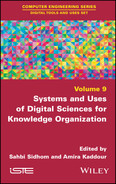1
Multi-Agent System and Ontology to Manage Ideas and Represent Knowledge: Creativity Challenge
1.1. Introduction
Every year, The University of Lorraine organizes a creativity workshop called “48 hours generating ideas” (48H). We observed that thousands of ideas (IdC) were generated during the last 48H creativity workshop in 2017 (Ecole d’été RRI 2017). In order to manage these ideas, a multi-agent system is studied and proposed since it has been proved to be efficient in a distributed process and to propose an ontology to represent knowledge. The concept of MAS appeared at the end of the 20th century. The multi-agent system has two forms of vision: the interaction among agents and the interaction among humans, the first, as an artificial intelligence (AI) concept attributed to Nils Nilsson “all AI is distributed-1980” and the second as artificial life (Alife) based in the complex adaptive behaviors of communities of humans (Weyns et al. 2004). By relating an individual to a program, it is possible to simulate an artificial world populated with interacting processes (Drogoul et al. 1992; Chávez Barrios 2019; Chávez Barrios et al. 2020). The individual is an agent who interacts according to their environment, which is clearly defined with respect to reality. These interactions among agents and their environments are an important aspect of the MAS. At the beginning of the 21st century, an initial model tool was used to create generic multi-agent platforms based on an organizational mode based on the core model agent-role-group (Gutknecht and Ferber 2000), and also multi-agent model is used involving some agents to hundreds focusing on the breakdown of a problem into simple ones that the agent can solve (Simonin and Ferber 2003). At present, MAS has been used to improve energy efficiency (Zhang et al. 2014). However, four topics were covered during the creativity workshop 48H: a) our intelligent system based in agents is complicated due to the multiple and different interactions among actors and roles without our target losing the ability “to assist participants of the creativity workshop to manage their ideas” and to develop an annotation system; as Ferber said “organization is the interaction of different groups” (Ferber 1994); b) collaborative interactions among actors and roles that are distant must be defined and every role might represent an agent; c) divergence actions are used by participants to create ideas using creative activities and collaborative creative methods; and d) convergence actions are used to produce idea cards as well as to store, share, evaluate and improve them. Several design methodologies of multi-agent systems exist: GAIA (Wooldridge et al. 2002; Zambonelli et al. 2003) and DOCK (Girodon et al. 2015b) are examples of these designs. Multi-agent systems have two principal methodologies (Esparcia et al. 2011), those oriented towards agents and those oriented towards organizations are based on organizational units, services, the environment and norms (Argente et al. 2009). Due to the uncountable times that agents are mentioned and the interaction of agents in a multi-agent system, we have to present some definitions about the concept of the agent; it has some primordial functions for the creation of our intelligent system. Since the last century and the beginning of this century, the concept of the agent and its characteristics has appeared. There are several definitions about agents, description of agents’ requirements, uses of agents (Shen and Norrie 1999) and descriptions of agents’ evolution (Vanhée et al. 2013). In software design, an agent represents structured aggregations of elements like events, actions, beliefs, plans and tasks (Kinny 2002). In actual definition, “agent” is a system whose behavior is teleonomic (Castelfranchi 2012), “goal-oriented” towards a certain state of the world; in another definition, an agent is specified as an active communicating entity which plays roles inside groups (Gutknecht and Ferber 2000). A final and, in our opinion, very important definition is “an agent is a computer system with independent action with respect to interventions of humans of other agents” (Jennings and Wooldridge 1998).
Having put forward the MAS, the next step is to define ontology. It is dedicated to ideas and specifically to assist participants in idea generation during the creativity workshop. In addition, our ontology represents knowledge from this CWS like ideas, processes, activities, actors, roles, methods, idea cards and possible solutions; this ontology is used to annotate ideas and to facilitate idea management. As an initial definition of the word, the etymology of ontology comes from ancient Greek, but the concept of ontology appeared in the 17th century in the work “Ogdoas Scholastic” by Jacob Lorhard (Øhrstrøm et al. 2008). Also, in the last century, the concept of ontology focused on the definition of objects, concepts, entities and relationships among them in a defined area (Genesereth and Nilsson 1987; Gruber 1995), and ontology works as a database with information, properties and relationships about concepts that exist in the world or a particular domain (Mahesh 1996).
This chapter presents the results about our multi-agent and ontology proposals. Initially, we present the context, problem and methodology; section 1.2 is about the state of the art of MAS and ontology approaches, and section 1.3 describes our approaches. Finally, the last section is dedicated to results and conclusions.
1.2. Multi-agent system (MAS) and ontology
1.2.1. MAS and ontology
1.2.1.1. Multi-agent system (MAS)
Inside the MAS, the concept of the agent is vital. The definition of agent in a general and complete AI idea: an agent could be human or robotic, the human agent acts through their physical sensors and acts with their extensions; the robot acts with its electronic sensor and effectors (Russell and Norvig 2003).
There are different varieties of agents, but in a robotic sense, autonomous agents should be reactive to changes in the environment and must be able to predict incompatible goal management and adaptivity (prediction) (Decugis and Ferber 1998). An agent, in our environment of creativity workshop 48H, is part of a team and can play one or more roles. An agent has several properties, such as the capacity to interact with their environment, the capacity to communicate with other agents, the necessity to achieve an objective, the capacity to manage their resources, the capacity to perceive the environment, the capacity to represent the environment partially or totally and eventually the capacity of reproduction (Ferber 1995). In Wooldridge’s conceptions, an agent is an informatic system in a specific environment, with autonomous actions to achieve its objectives (Wooldridge et al. 1999). A final definition is that agents interact amongst themselves to achieve a general objective, and there exist two kinds of agents, cognitive and reactive (Ferber 1995). Artificial intelligence (AI) is an important discipline that defines an agent in different ways. AI borrows concepts (states, actions and rational agents) and techniques for autonomic computing (Kephart and Walsh 2004).
1.2.1.2. Ontology
In the last century, the concept of ontology focused on the definition of objects, concepts, entities and relationships between them in a defined area (Genesereth and Nilsson 1987; Gruber 1995), and ontology works as a database with information, properties and relationships about concepts that exist in the world or a domain (Mahesh 1996).
Berners-Lee suggested using ontologies in the context of the Internet in order to bring a semantic dimension of the Web and to use collections of information called ontologies that is a component of the semantic web (Berners-Lee and Hendler 2002) that can be shared and reused (Elbassiti and Ajhoun 2014). The semantic web allows us to build ontologies by using a set of languages such as RDF, RDFs and OWL to structure knowledge resources.
The creation of a domain ontology needs to define the concepts, procedures, activities and relationships that belong specially to this domain or field in detail, trying to eliminate ambiguity and doubts due to the communication among web researches and machines (computers) using software applications, as explained by Staab and Studer (2004).
According to Mathieu d’Aquin, “ontologies represent the essential technology that enables and facilitates interoperability at the semantic level, providing a formal conceptualization of the data which can be shared, reused, and aligned” (D’Aquin and Noy 2012).
There are several existing libraries dedicated to ontology using some formats to link their information, such as RDF, which guarantees the interoperability, making it possible for applications to reuse data and to link diverse data (D’Aquin and Noy 2012). BioPortal is a library of biomedical ontologies developed by the National Center for Biomedical Ontologies (Noy et al. 2009).
1.2.2. MAS methodologies
There are some methodologies to design a multi-agent system (MAS). These methodologies involve mainly roles, agents, interactions among agents and the environment. The first methodologies were developed at the end of the century based on interaction between roles (Wooldridge et al. 1999), but in this century, several methodologies have appeared, such as ICTAM (Elsawah et al. 2015), DOCK (Girodon et al. 2015a), MOBMAS (Tran and Low 2008), ADELFE (Picard and Gleizes 2006) and GAIA (Wooldridge et al. 2000; Zambonelli et al. 2003). Here, we will describe the most important characteristics of each one.
1.2.2.1. Wooldridge’s GAIA methodology
This technique uses analysis and design; it moves from abstract to gradually more concrete concepts; from analysis, roles and interaction models; from design agent, services and acquaintance models (Wooldridge et al. 2000). We used it in the 48H organization due to the details of the system and the full definition of agents.
1.2.2.2. DOCK methodology
DOCK’s approach (Gabriel 2016) allows us to model MAS based on knowledge management. This methodology describes an intelligent knowledge system; it uses human organizations. The DOCK methodology defines four elements: the organizational structure to identify agents (roles) and also the process, the activity and the role models to define every simple piece of knowledge in detail. The model defines three stages: human organization, agent organization and interactions.
1.2.2.3. Other methodologies
There are other styles to analyze and design MAS MOBMAS uses ontology (Tran and Low 2008), which describes that most of the methodologies are deficient in design, organization and interaction of agents; for this reason, MOBMAS is focused mainly on five descriptive activities focused in agents. The SABPO style tries to achieve the goals of the organization as a main target of the agent’s interactions (Petta et al. 2003). The ADELFE, MOBMAS and SABPO techniques require agents as well as identification and definition of agents and their principal cooperative activities (Picard and Gleizes 2006; Rougemaille et al. 2009).
1.2.3. Methodologies to design ontologies
Ontology requires a well-defined process to represent reality. Several methodologies already exist to build ontologies. We will present some approaches to build ontologies.
a) Enterprise approach (Uschold and King 1995; Jones et al. 1998) is based on four steps: identification of the purpose, of the scope, of terms and finally formal evaluations; it might have a cycle from formal evaluations to identifying the scope.
b) Methontology: the goal of this methodology defined by Fernandez and Goméz-Pérez (Fernandez et al. 1997) is to clarify the activities they should perform. They claim ontology is an art and try to transform into engineering. It has seven steps: specification to obtain natural languages ontology, knowledge acquisition, conceptualization, integration to get uniformity, implementation, evaluation and documentation.
b) The KBSI IDEF5 is devoted to assisting in the creation, modification and maintenance of ontologies according to Jones in Jones et al. (1998) and Peraketh et al. (1994). The process has five steps: organizing and scope, data collection, data analysis, initial ontology and evaluation, as well as a final step to design ontologies,
d) Methodology to design ontologies from organizational models, the phases and activities applied to creativity workshops that represent the ontology process (Gabriel et al. 2019). This describes an ontology to model knowledge in a creativity workshop, its description:
Phase 1: Definition
- definition of domain, scope and purpose;
- definition of the question-skills of the ontology (aptitudes).
Phase 2: Conceptualization
- conceptualization and acquisition;
- reuse of existing ontology concepts.
Phase 3: Development
- development of the ontology (programming, formalization);
- population of the ontology.
Phase 4: Validation/Evaluation
- evaluation.
1.3. MAS and ontology: our approach proposal
The MAS requires the most detailed information about agents and the methods described here try to achieve this but GAIA has provided initial definitions since the beginning of this century. With respect to the ontology, every previous ontology process has roughly scope, purpose, concepts, relationships and evaluation dedicated to its domain; for this reason, we work with GAIA and the enterprise approach ontology.
1.3.1. MAS methodology GAIA
The models in GAIA have two phases, first the analysis phase with the role model and interaction model and the second phase, the design phase (see Figure 1.1).
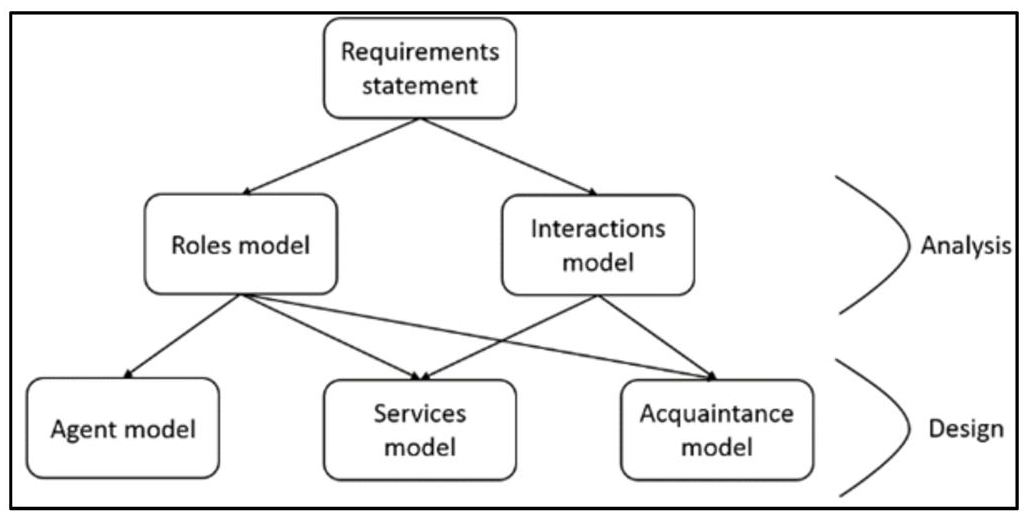
Figure 1.1 Relationships between the GAIA models (Picard and Gleizes 2006, p. 3)
The design processes of GAIA have three models, agent model, services model and acquaintance model that help us to understand the roles and interactions described before in the analysis phase (Wooldridge et al. 2000).
The objectives of a multi-agent system are to manage idea cards, to take decisions and to enhance creative techniques by means of the reactive and cognitive agents in the environment of the 48H creativity workshop. The most abstract concept is the system. The organization is a collection of roles and interactions among them (see Figure 1.2).

Figure 1.2 Analysis of concepts (Wooldridge et al. 2000, p. 4)
1.3.2. Applying the ontology, Uschold’s ontology
The proposed methodology to build our ontology must help to represent the evolution of the ideas, the individual ideas, after-idea cards and finally the possible solutions, coming out of this organizational model called 48H. This methodology follows a process based primordially on building the ontology. Initially, it expresses the meaning of the organization after it works on the design of ontology, finally the judgment and documentation.
The methodology chosen is the enterprise ontology of Uschold (Uschold and King 1995). It has four phases. With this ontology, we can easily define the phases and identify the steps with the finality to do several iterations to correct our job. The Uschold ontology (see Figure 1.3) focuses mainly on building the ontology that is something that we appreciate; for us, the capture, coding and integrating existing ontologies are vital steps, without forgetting the iteration to improve.
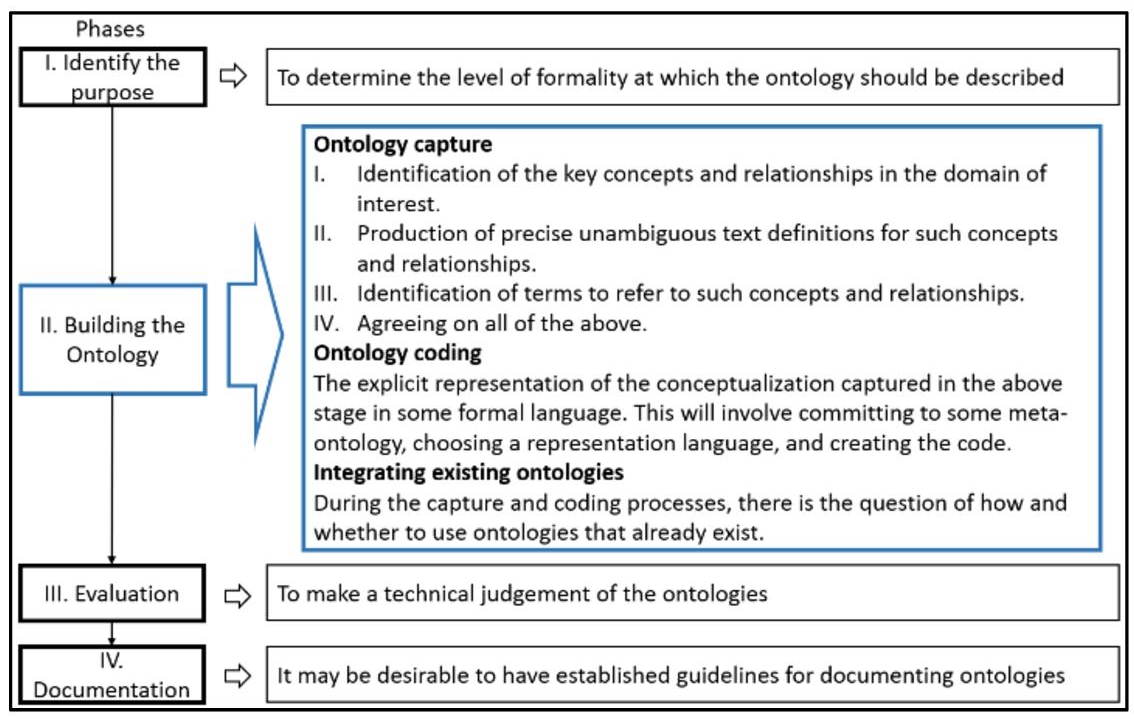
Figure 1.3 Ontology Uschold phases.
1.4. Results
1.4.1. Multi-agent system results
1.4.1.1. Analysis: Roles model
We will describe the roles of the agents, and we have chosen to give the same role to the agents as to the participants of the creativity workshop, i.e. “creative expert”, “industrial manager”, “organizer”, “solver participant” and “technical expert”. The objective of the agents is to assist the participants to achieve their activities and to manage their ideas during the creativity workshop process.
The schema of the solver participant (see Table 1.1) details the production of ideas in idea cards. There are 15 protocols (shown in the row Protocols and activities in Table 1.1) where the solver participant acts. The permissions produce an individual idea using individual activities, to produce at least two idea cards using a collaborative creative method, to have the same problem in WorkIdeaCards at the time of sharing with a colleague team and to evaluate idea cards from the same problem except our idea card.
Table 1.1. Role solver participant
| Role schema | Name |
|---|---|
| Description and objective | The role solver participant: To produce ideas in an individual way using activities. To produce idea cards by means of collaborative creative methods. |
| Protocols and activities | RequirementsInscription (Name, Last name, Institution), GiveRequirements (Name, Last name, Institution), Assignation (Assign_InstToWork, Assigned_ind, assigned_rol), Provides (part_team, problem). Offer_activity, SelectActivity, WorkIdeas, Offer_method, SelectMethod, WorkIdeaCards, Improve, CompareIdeas, SendingIdeaCards, ReceivingPossibleSolutions, WatchingPossibleSolutions, AwardsEnd |
| Permissions | The actor must be registered as a solver participant; To produce at least one individual idea using individual activities. To produce two idea cards using a collaborative creative method. To have the same problem in WorkIdeasCards at the time of sharing with colleague team. To evaluate idea cards from the same problem except our idea cards and the idea cards from our team partner. |
| Responsibilities | |
| Liveness | Solverparticipant = (RequirementsInscription.GiveRequirements)+ · (Assignation)+ · (Provides)+ · (Offer_activity.SelectActivity.WorkIdeas)+ · (Offer_method.SelectMethod.WorkIdeaCards.Improve)+ ·(CompareIdeas)+ · (SendingIdeaCards.ReceivingPossibleSolutions)+ · (WatchingPossibleSolutions.AwardsEnd)+ |
| Safety | Idea > 0 Idea card = 2 by team. |
1.4.1.2. Analysis: Interaction model
This second model describes the communication protocols for each agent. The agent’s protocol has some elements (see Figure 1.4) that help us to improve the explanation about the protocol’s description (Colleman et al. 1996) in the interaction of the agents.
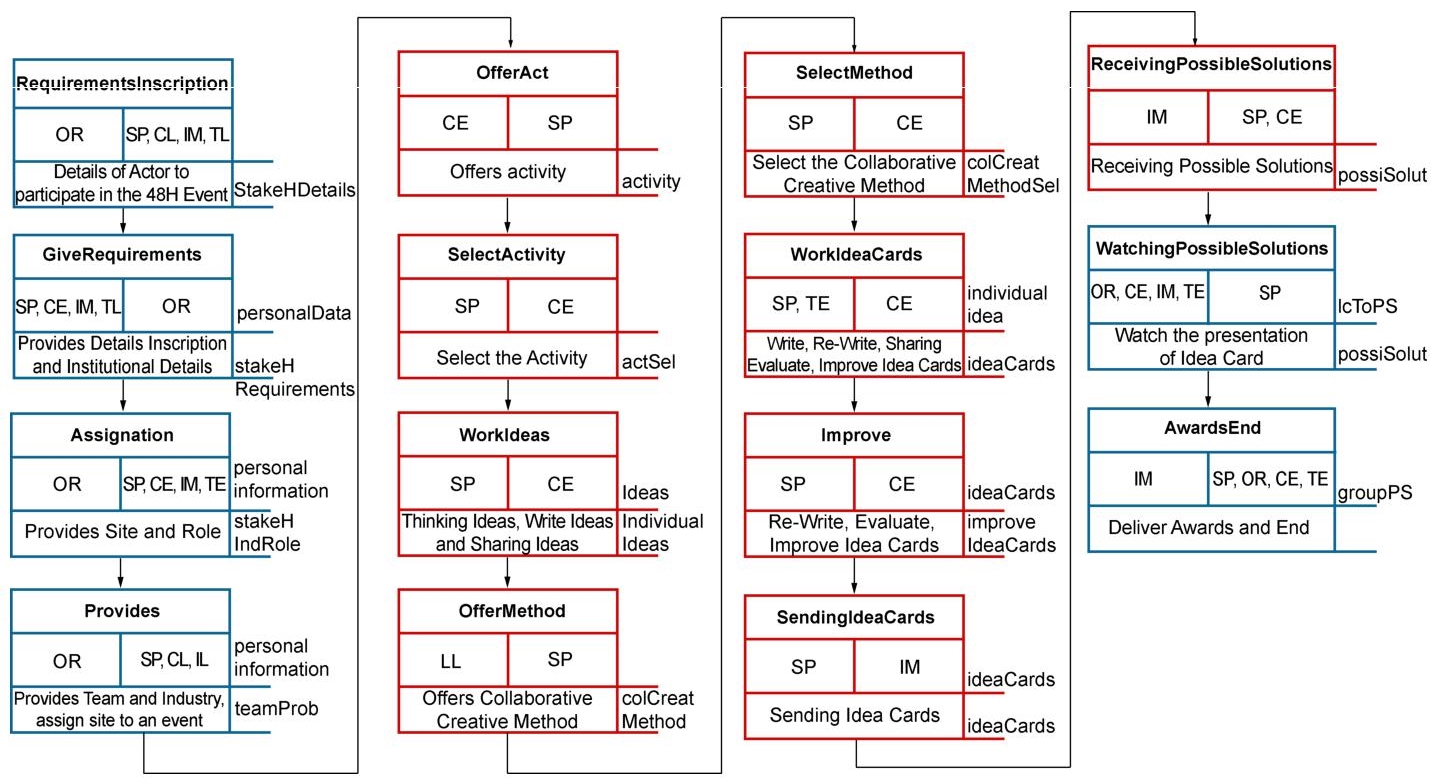
Figure 1.4 Definition of protocols associated with the role solver participant.
1.4.1.3. Design: Agent model
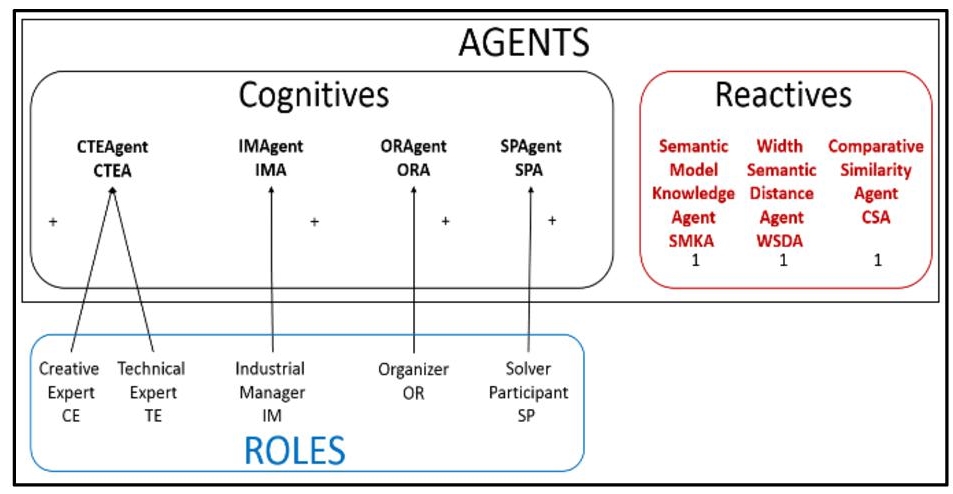
Figure 1.5 Definition of protocols associated with the role solver participant.
In the agent model (see Figure 1.5), we identify seven agents and their instances that will make up the system. During the creativity workshop, the five roles were easily identified according to the agent model proposed. The role creative expert and technical expert will form an agent called creative technological expert agent (CTEAgent-CTEA); the number of CTEA agents is one or more. The rest of the roles have their agents, noting that the agent organizer (ORAgent-ORA) has one or more instances. However, we add three agents, semantic model knowledge agent (SMKA), width semantic distance agent (WSDA) and the comparative similarity agent (CSA). These agents help us to order ideas according to semantic distance, width density and comparative similarity of idea cards.
1.4.1.4. Design: Service model
The principal services during the creativity workshop 48H are:
“To obtain information of actors and assignation of roles”, “selection and application of activity for ideas”, “selection and application of methods for idea cards”, “evaluation by partners and improving idea cards as a goal”, “classification of idea cards” and “sending possible solutions”. These services (see Table 1.2) are functions that the agents have to execute according to the protocols described before.
Table 1.2. Role solver participant
| Service | Inputs | Outputs | Preconditions | Post-conditions |
|---|---|---|---|---|
| Obtain information of actors and assignation of roles | Actor details Name, last name, institution, sex, date of birth | Actor requirements | Event = 1 | Institution >= 1 Industry >= 1 Role >= 2 Team>= 2 Problem >= 1 |
| Selection and application of activity for ideas | Group, creative technical expert, activities | Ideas | Ideas per participant at least in mind | Idea > 0 |
| Selection and application of methods for idea cards | Thousands of ideas, many methods | Idea cards | 2 idea cards per group = 2 | Idea cards > 2 |
| Evaluation by partners and improving idea card as a goal | Two ideas per group | Idea cards | 2 idea cards per group | Idea cards > 2 |
| Classification of idea cards | n idea cards | n idea cards | At least 2 idea cards | Idea cards > n |
| Sending possible solutions | Idea cards | Possible solutions | 2 possible solutions per group | Possible solution >= 2 |
1.4.1.5. Design: Acquaintance model
The acquaintance model (see Figure 1.6) determines communication between the different agents. The agents creative expert CTEA, Organizational ORA, solver participant SPA and industrial manager agent IMA communicate during the entire creativity workshop. The agents CTEA and SPA also interact with the agents: semantic model knowledge SMKA and width semantic distance WSDA.
The agents SMKA, WSDA and CSA take action with the purpose of classifying the idea cards at the end of the creation, sharing, evaluation (among the partner group and the rest of the groups) and improving.

Figure 1.6 Acquaintance model
1.4.2. Ontology results
The domain is an ontology dedicated to creativity, and we called it “the collaborative creative ideas ontology”, or CCIDEAS.
It aims to describe and inform all the concepts related to the creativity workshop challenge. These concepts are identified inside of an organizational model.
The purposes of this ontology are to represent knowledge and ideas and to understand the creativity workshop. The ontology will be used to compare ideas in the intelligent system.
1.4.2.1. Creation of concepts
These concepts and relationships determine the ontology. The definition of every concept that is part of this creativity workshop (see Table 1.3) will be used to create a triplet model based on three inter-related concepts.
Table 1.3. Definition of concepts
| Name of the concept | Definition |
|---|---|
| 1 Activity | The action(s) that the actor follows to produce ideas (I) in the phase of divergence. |
| The activities of divergence used to produce individual ideas. | |
| Type: String. | |
| 2 Actor | The person who will participate in the event and can take a role in solving problems. The concept will indicate the role or several roles to assume during a CWS. Type: String. |
| 3 Collaborative creative method (CCM) | Set of instructions applied by solver participants to generate idea cards (IC). |
| The methods of convergence are used to produce idea cards. | |
| Type: String. | |
| 4 Event | The name of the CWS and its edition. Type: String. |
| 5 Idea | The individual ideas (I) are produced in the phase of divergence; they are created using combinational, exploratory and transformational techniques with individual activities. |
| The actor captures the initial individual idea. Type: String. | |
| 6 IdeaDesc | Idea’s description. Type: String. |
| 7 IdeaCard | The result of the use of ideas (I) and collaborative creative methods (CCM). |
| An actor with the role of the solver participant and from a team creates idea cards using CCM. | |
| 8 ICDesc | Idea card’s description. |
| Type: String. | |
| 9 ICTitle | Idea card’s title. |
| Type: String. | |
| 10 ICScenery | Idea card’s scenery. |
| Type: String. | |
| 11 ICPrioCli | Idea card’s priority client. |
| Type: String. | |
| 12 ICAdvant | Idea card’s advantage. |
| Type: String. | |
| 13 ICRisk | Idea card’s risk. |
| Type: String. | |
| 14 Industry | The name of the industry; this concept has the problem. |
| The industrial manager proposes the industry that contains the problem. | |
| Type: String. | |
| 15 Problem | The reasons why the organization creates the creativity workshop CWS events every year. Industries like Assystem, Bostik, CEA Tech, Decathlon, GRDF, ICM, MSA Safety, Muller, Normande Aerospace, Pierre Fabre and Scarabée Biocop participate in those events. The problem is assigned to a team by means of the industry. Type: String. |
| 16 Role | The type of character that the actor takes (organizer, solver participant, creative expert, technical expert, Industrial manager). Type: String. |
| 17 Site | The place where actors will work (ASU BAHRAIN, CESI NANTERRE, ENSGSI NANCY, etc.). The site given to an actor. Type: String. |
| 18 Team | The set of actors with the same role (solver participant), event, problem, site, name of team and color. (Str_Ass_1, Lyo_Assy_1, Uca1, Str_Ass_2, etc.). An actor takes part of a team. Type: String. |
| 19 Vocabulary | The vocabulary is formed by ADJECTIVE, ADVERB, NOUN, VERB, ARTICLE, PRONOUN, PREPOSITION, CONJUNCTION AND INTERJECTION; some fields of the idea card’s concept use these concepts such as title, description, priority client, name, scenery, advantages and risk. The vocabulary is part of idea’s description. |
| Type: String. | |
| 20 Organizer | The actor who takes the role in activities of assignation of roles, industries, team and event. Initially, this role creates the event and asks for information from the actors with the purpose of doing the inscription. Type: String. |
| 21 Solver participant | This concept is part of the roles and part of the team. The site is assigned to the solver participant; other relationships are: |
| Select activity, | |
| Create ideas, | |
| Send possible solutions. | |
| Type: String. | |
| 22 Creative expert | The creative expert offers activities and collaborative creative methods to the team of solver participants. |
| Type: String. | |
| 23 Technical expert | Technical expert helps teams to improve idea cards. |
| Type: String. | |
| 24 Industrial manager | The industrial manager proposes an industry to the creativity workshop. |
| Type: String. | |
| 25 Possible Solutions | The concept possible solutions are the idea cards with best score according to the semantic skills like width, semantic distance and similarity. |
1.4.2.2. Creation of relationship proposed
The creation of relationships uses the format subject–verb–object with the purpose of creating sets of three elements:
– the term of relationships;
– the concepts (Bachimont 2000) where the relationship represents the verb (see Table 1.4);
– and present the global ontology (Figure 1.7).
1.5. Conclusion
Our main contribution to MAS and ontology is to assist participants during the creativity workshop to manage their ideas and knowledge and to put forward an intelligent system based in MAS and to develop an annotation system (ontology). The global frontiers of the system (see Figure 1.8) show the relationship between the agents SKMA, WSDA and CSA with the objects of the system. The creativity support system interface human machine (see Figure 1.9) presents the agents, events and operations (Chávez Barrios 2019; Chávez Barrios et al. 2020).
With respect to agents: the agents inside our MAS manage ideas, but in the future, other agents could be focused to assist participants in the selection of a better activity or collaborative creative method. With respect to ontology: the ontology system (see Figure 1.7) presents the quantity of 25 concepts and 34 relationships; the heart of the ontology is formed by the idea card, actor and method.
1.6. Appendices
Table 1.4. Definition of relationships
| Relation name proposed | Domain (concepts) | Range (concepts) | Triplet and/or definitions |
|---|---|---|---|
| 1 Select | Solver participant | Activity. Examples: brainstorming, write storming, bend it and shape it, brain borrow, copy cat, etc. | Solver participant selects activity. The property indicates that the solver participant selects an activity to create individual ideas during the phase of divergence. |
| 2 Offers | Creative expert | Activity. Examples: storming,brainstorming,bend writeit and shape it, brain borrow, copy cat, etc. | Creative expert offers activity. The property indicatesoffers an activity.that creative |
| 3 Plays | Actor | Role. Examples: creative expert,industrialtechnicalmanager,expert,solver participant and organizer | Actor plays a role. |
| 4 Assign | Organizer | Role. Examples: creative expert, technical expert, industrialsolver participantmanager and | Organizer assigns a role. The property indicates that the organizer assigns all the roles in the creativity workshop. |
| 5 Propose | Industrial manager | Industry. Examples: Decathlon, ICM, Bostik, etc. | Industrial manager proposes an industry. The property indicates that the industrial manager proposes an industry. |
| 6 Create | Organizer | Event. Examples: 48h InnovENT-Edition 2016, Operation 2015 InnovENT-E 48 hours to bring ideas to life | Organizer creates an event. |
| 7 Assign | Organizer | Site. Examples: INSA LYON, ENSGSI, UCA MARRAKECH, etc. | Organizer assigns site. |
| 8 Assign | Organizer | Industry. Examples: Decathlon, ICM, Bostik, etc. | Organizer assigns industry. |
| 9 Assign | Organizer | Team. Examples: Nan_Dec_1, Nan_Dec2, Str_Ass_2, etc. | Organizer assigns teams. |
| 10 Requires | Organizer | Actor. Examples: any institutional, educative or industrial person interested in creativity and solving problems | Organizer requires actor. |
| 11 Help | Technical expert | Team. Examples: Nan_Dec_1, Nan_Dec2, Str_Ass_2, etc. | Technical expert helps team. The property indicates that technical experts help teams. |
| 12 IsAssignedTo | Industry | Team. Examples: Nan_Dec_1, Nan_Dec2, Str_Ass_2, etc. | Industry is assigned to team. |
| 13 Receive | Industrial manager | Possible solutions | Industrial manager receives possible solutions. The property indicates that industrial manager receives the possible solutions. |
| 14 IsPartOf | Actor | Team. Examples: Nan_Dec_1, Nan_Dec2, Str_Ass_2, etc. | Actor is part of team. |
| 15 IsAssignedTo | Site | Event. Examples: 48h InnovENT-Edition 2016, Operation 2015 InnovENT-E 48 hours to bring ideas to life | Site is assigned to an event. |
| 16 Send | Solver participant | Possible solutions | Solver participant sends possible solutions. The property indicates that solver participant sends the possible solutions. |
| 17 Present | Team | Possible solutions | Team presents possible solutions. The property indicates that team presents the possible solutions. |
| 18 IsAssignedTo | Site | Role. Range: technical expert, solver participant and creative expert | Site is assigned to role. |
| 19 IsAssignedTo | Team | Role. Range: technical expert, solver participant and creative expert | Team is assigned to role. |
| 20 Create | Team | Idea card | Team creates idea card. The property indicates that team creates the idea cards. |
| 21 Improve | Team | Idea card | Team improves idea card. The property indicates that team improves the idea cards. |
| 22 Select | Team | CCM. Examples: six hats of thinking, the shirt off your back, puzzle pieces, organizational brainstorms, best off, rice storm, etc. | Team select CCM. The property indicates that team selects the collaborative creative method. |
| 23 Use | CCM | Idea | CCM uses ideas. |
| 24 Form | Idea | Idea cards | Ideas form idea card. |
| 25 Use | Idea card | CCM. Examples: six hats of thinking, the shirt off your back, puzzle pieces, organizational brainstorms, nest off, rice storm, etc. | Idea card uses CCM. |
| 26 Offer | Creative expert | CCM. Examples: Six hats of thinking, the shirt off your back, puzzle pieces, organizational brainstorms, best off, rice storm, etc. | Creative expert offers CCM. |
| 27 IsPartOf | IdeaDesc | Idea | IdeaDesc is part of idea. The property indicates that idea description (IdeaDesc) is part of the idea. |
| 28 Create | Solver participant | Idea | Solver participant creates idea. The property indicates that solver participant creates ideas. |
| 29 IsPartOf1 | ICDesc | Idea card | ICDesc is part 1 of idea card. The property indicates that the field idea card description (ICDesc) is part of the idea card. |
| 30 IsPartOf2 | ICTitle | Idea card | ICTitle is part 2 of idea card. The property indicates that the field idea card title (ICTitle) is part of the idea card. |
| 31 IsPartOf3 | ICScenery | Idea card | ICScenery is part 3 of idea card. The property indicates that the field idea card scenery (ICScenery) is part of the idea card. |
| 32 IsPartOf4 | ICPrioCli | Idea card | ICPrioCli is part 4 of idea card. The property indicates that the field idea card priority clients (ICPrioCli) is part of the idea card. |
| 33 IsPartOf5 | ICAdvant | Idea card | ICAdvant is part 5 of idea card. The property indicates that the field idea card advantage (ICAdvant) is part of the idea card. |
| 34 IsPartOf6 | ICRisk | Idea card | ICRisk is part 6 of idea card. The property indicates that the field idea card risk (ICRisk) is part of the idea card. |
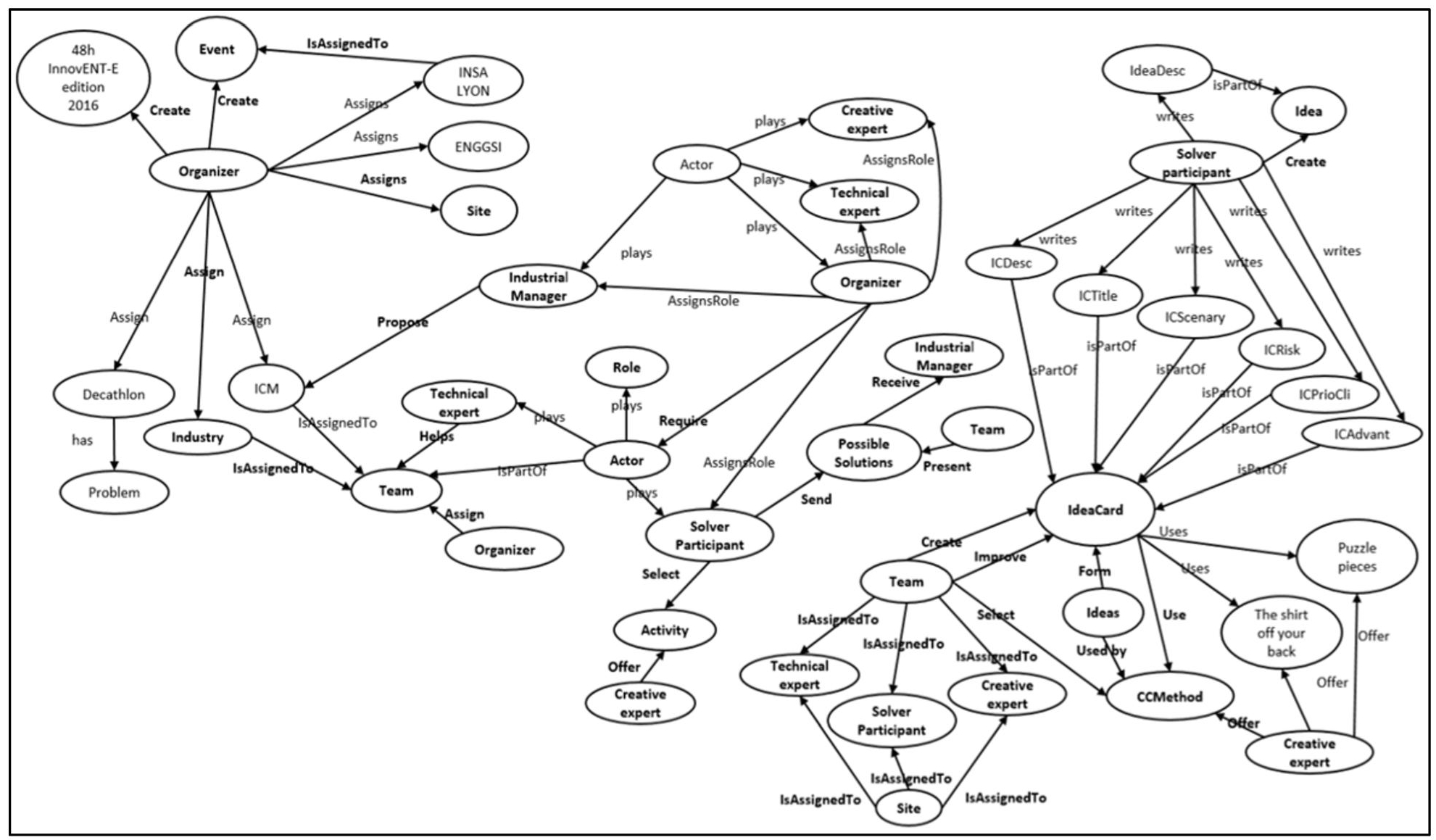
Figure 1.7 Global ontology
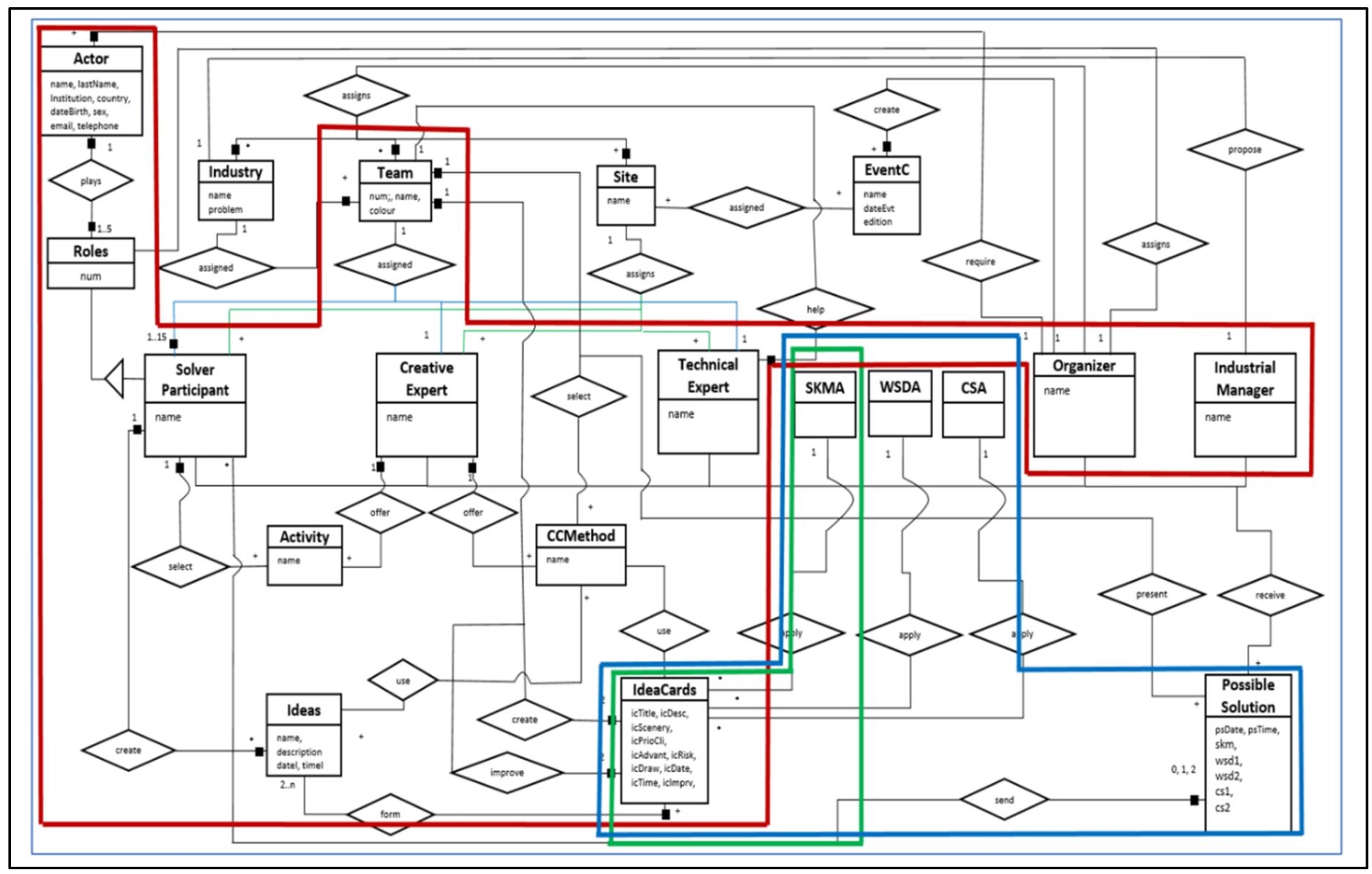
Figure 1.8 Global frontiers of the system.
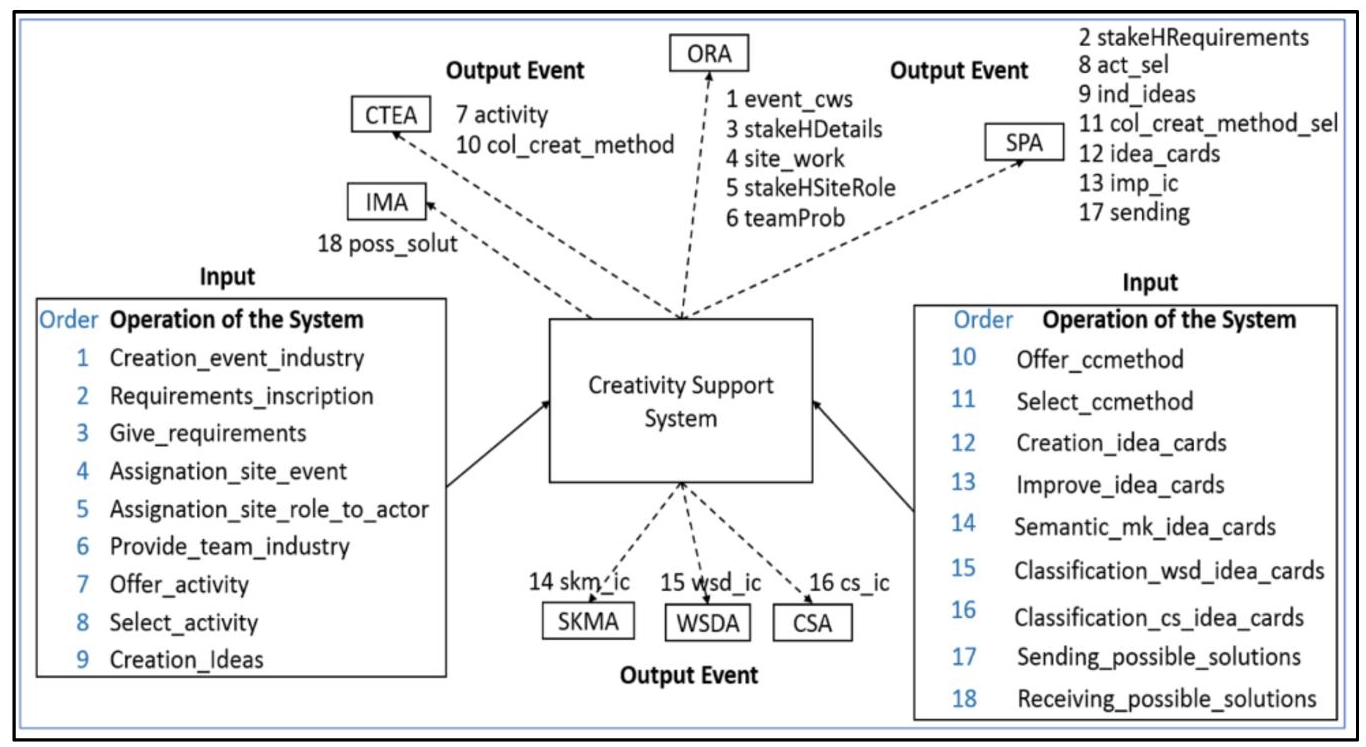
Figure 1.9 Creativity support system interface human machine.
1.7. References
- Argente, E., Julian, V., Botti, V. (2009). MAS modeling based on organizations. Agent-Oriented Softw. Eng. IX 9th Int. Work., 16–30.
- Bachimont, B. (2000). Engagement sémantique et engagement ontologique : conception et réalisation d’ontologies en ingénierie des connaissances. Ingénierie des connaissances : évolutions récentes nouveaux défis, 505.
- Berners-Lee, T. and Hendler, J. (2002). The semantic web. Sci. Am., 21 [Online]. Available at: http://www.w3.org/2002/07/swint.
- Castelfranchi, C. (2012). Guarantees for autonomy in cognitive agent architecture, Intelligent Agents, ECAI-94 Workshop on Agent Theories, Architectures, and Languages. Amsterdam, August 8–9.
- Chávez Barrios, P. (2019). Design of information and technology tools to support the process of creativity and innovation. PhD Thesis, Université de Lorraine.
- Chávez Barrios, P., Montocolo, D., Sidhom, S. (2020). Results of multi-agent system and ontology to manage ideas and represent knowledge in a challenge of creativity. OCTA Multi-conference Proceedings: Information Systems and Economic Intelligence (SIIE), 208, February, Tunis, Tunisia [Online]. Available at: https://multiconference-octa.loria.fr/multiconference-program/.
- Coleman, D. and Arnold, P. (1996). Fusion, La méthode orientée-object de 2e génération. Méthodologies du logiciel, ISSN 1242-5656
- D’Aquin, M. and Noy, N.F. (2012). Where to publish and find ontologies? A survey of ontology libraries. J. Web Semant., 11, 96–111.
- Decugis, V. and Ferber, J. (1998). Action selection in an autonomous agent with a hierarchical distributed reactive planning architecture. AGENTS ‘98 Proc. Second Int. Conf. Auton. Agents, 354–361.
- Drogoul, A., Ferber, J., Cambier, C. (1992). Multi-agent simulation as a tool for analysing emergent processes in societies [Online]. Available at: https://horizon.documentation.ird.fr/exl-doc/pleins_textes/pleins_textes_5/b_fdi_31-32/35495.pdf.
- Ecole d’été RRI (2017). Les 28–29 août 2017 : “L’innovation agile : quels défis pour les individus, les organisations et les territoires ?” [Online]. Available: https://rni2017.event.univ-l.
- Elbassiti, L. and Ajhoun, R. (2014). Semantic representation of innovation, generic ontology for idea management. J. Adv. Manag. Sci., 2(1), 128–134.
- Elsawah, S., Guillaume, J.H.A., Filatova, T., Rook, J., Jakeman, A.J. (2015). A methodology for eliciting, representing, and analysing stakeholder knowledge for decision making on complex socio-ecological systems: From cognitive maps to agent-based models. J. Environ. Manage., 151, 500–516.
- Esparcia, S., Argente, E., Botti, V. (2011). An agent-oriented software engineering methodology to develop adaptive virtual organizations. IJCAI Int. Jt. Conf. Artif. Intell., (1), 2796–2797.
- Ferber, J. (1994). Coopération réactive et émergence. Intellectica, 19, 19–52 [Online]. Available at: https://www.persee.fr/doc/intel_0769-4113_1994_num_19_2_1460.
- Ferber, J. (1995). Les systèmes multi-agents vers une intelligence collective. InterEditions, Paris.
- Fernández-López, M., Gómez-Pérez, A., Juristo, N. (1997). METHONTOLOGY: From ontological art towards ontological engineering. AAAI-97 Spring Symposium Series, Stanford University, EEUU, 24–26 March.
- Gabriel, A. (2016). Gestion des connaissances lors d’un processus collaboratif de créativité. Université de Lorraine, ERPI Lab.
- Gabriel, A., Chávez Barrios, P., Monticolo, D. (2019). Methodology to design ontologies from organizational models: Application to creativity workshops. Knowl. Eng. Manag. Appl. to Innov., 33(2), 148–159.
- Genesereth, M. and Nilsson, N. (1987). Logical foundations of artificial intelligence: Nomotonic reasoning. Logical Foundations of Artificial Intelligence [Online]. Available at: https://www.sciencedirect.com/book/9780934613316/logical-foundations-of-artificial-intelligence.
- Girodon, J., Monticolo, D., Bonjour, E. (2015a). How to design a multi agent system dedicated to knowledge management; the DOCK approach. Computer Science, 113–121.
- Girodon, J., Monticolo, D., Bonjour, E., Perrier, M. (2015b). An organizational approach to designing an intelligent knowledge-based system: Application to the decision-making process in design projects. Adv. Eng. Informatics, 29(3), 696–713.
- Gruber, T.R. (1995). Toward principles for the design of ontologies. Int. J. Hum.-Comput. Stud., 43(5), 907–928.
- Gutknecht, O. and Ferber, J. (2000). MadKit: A generic multi-agent platform. Proc. Fourth Int. Conf. Auton., Agents – AGENTS, 78–79.
- Jennings, N.R. and Wooldridge, M. (1998). Applications of Intelligent Agents. Agent Technology: Formations, Applications and Markets. Springer-Verlag, Berlin.
- Jones, D., Bench-Capon, T., Visser, P. (1998). Methodologies for ontology development. Computer Science, June.
- Kephart, J.O. and Walsh, W.E. (2004). An artificial intelligence perspective on autonomic computing policies. Proc. – Fifth IEEE Int. Work. Policies Distrib. Syst. Networks, 3–12.
- Kinny, D. (2002). A visual programming language for plan execution systems. Proc. First Int. Jt. Conf. Auton. Agents Multi-Agent Syst. (AAMAS-2002, Featur. 6th AGENTS, 5th ICMAS 9th ATAL), Bologna, 15–19 July.
- Mahesh, K. (1996). Ontology development for machine translation: Ideology and methodology. Report, Comput. Res. Lab. New Mex. State Univ. MCCS-96-292.
- Noy, N.F., Shah, N.H., Whetzel, P.L., Dai, B., Dorf, M., Griffith, N., Jonquet, C., Rubin, D.L., Storey, M.-A., Chute, C.G., Musen, M.A. (2009). BioPortal: Ontologies and integrated data resources at the click of a mouse. Nucleic Acids Res., 37, 170–173.
- Øhrstrøm, P., Shârphe, H., Uckelman, S. (2008). Jacob Lorhard’s ontology: A 17th century hypertext on the reality and temporality of the world of intelligibles. In Conceptual Structures: Knowledge, Visualization and Reasoning, Eklund, P. and Haemmerlé, O. (eds). Springer, Berlin, Heidelberg.
- Peraketh, B., Menzel, C., Mayer, R.J., Fillion, F., Futrell, M.T., DeWitte, P.S., Lingineni, M. (1994). Ontology capture method. Technical paper, KBSI, College Station.
- Petta, P., Tolksdorf, R., Zambonelli, F. (2003). Engineering Societies in the Agents World III. Springer, Berlin, Heidelberg.
- Picard, G. and Gleizes, M. (2006). The Adelfe methodology. In Methodologies and Software Engineering for Agent Systems – The Agent-Oriented Software Engineering Handbook, Bergenti, F., Gleizes, M.-P., Zambonelli, F. (eds). Springer, New York.
- Rougemaille, S., Arcangeli, J.P., Gleizes, M.P., Migeon, F. (2009). ADELFE design, AMAS-ML in action: A case study. Lect. Notes Comput. Sci. (including Subser. Lect. Notes Artif. Intell. Lect. Notes Bioinformatics), 5485 LNAI.
- Russell, S. and Norvig, P. (2003). Artificial Intelligence: A Modern Approach, 2nd edition. Prentice Hall, Upper Saddle River.
- Shen, W. and Norrie, D.H. (1999). Agent-based systems for intelligent manufacturing: A state-of-the-art survey. Knowl. Inf. Syst., 1(2), 129–156.
- Simonin, O. and Ferber, J. (2003). Un modèle multi-agent de résolution collective de problèmes situés multi-échelles. RSTI/hors série, JFSMA, 1–13.
- Staab, S. and Studer, R. (2004). Handbook on Ontologies. Springer-Verlag, Berlin, Heidelberg.
- Tran, Q.N.N. and Low, G. (2008). MOBMAS: A methodology for ontology-based multi-agent systems development. Inf. Softw. Technol., 50(7–8), 697–722.
- Uschold, M. and King, M. (1995). Towards a methodology for building ontologies. Methodology, 80(July), 275–280.
- Vanhée, L., Ferber, J., Dignum, F. (2013). Agent-based evolving societies (extended abstract) categories and subject descriptors. AAMAS ‘13: Proceedings of the 2013 International Conference on Autonomous Agents and Multi-Agent Systems, May, 1241–1242.
- Weyns, D., Parurak, V.D.H., Michel, F. (2004). Environments for multi-agent systems. The Knowledge Engineering Review, 00:0, 1–15.
- Wooldridge, M., Jennings, N.R., Kinny, D. (1999). A methodology for agent-oriented analysis and design: A conceptual framework. Proc. Third Int. Conf. Auton. Agents, 69–76.
- Wooldridge, M., Jennings, N.R., Kinny, D. (2000). The Gaia methodology for agent-oriented analysis and design. J. Auton. Agents Multi-Agent Syst., 3(3), 285–312.
- Wooldridge, M., Fisher, M., Huget, M., Parsons, S. (2002). Model checking multi-agent systems with MABLE. AAMAS ‘02: Proceedings of the First International Joint Conference on Autonomous Agents and Multiagent Systems, July, 952–959.
- Zambonelli, F., Jennings, N.R., Wooldridge, M. (2003). Developing multiagent systems: The Gaia methodology. ACM Trans. Softw. Eng. Methodol., 12(3), 317–370.
- Zhang, W., Liu, W., Wang, X., Liu, L., Ferrese, F. (2014). Distributed multiple agent system based online optimal reactive power control for smart grids. IEEE Trans. Smart Grid, 5(5), 2421–2431.
Note
- Chapter written by Pedro Chávez BARRIOS, Davy MONTICOLO and Sahbi SIDHOM.
